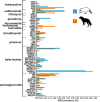Comparison of Antimicrobial-Resistant Escherichia coli Isolates from Urban Raccoons and Domestic Dogs
- PMID: 33990315
- PMCID: PMC8315739
- DOI: 10.1128/AEM.00484-21
Comparison of Antimicrobial-Resistant Escherichia coli Isolates from Urban Raccoons and Domestic Dogs
Abstract
Wildlife can be exposed to antimicrobial-resistant bacteria (ARB) via multiple pathways. Spatial overlap with domestic animals is a prominent exposure pathway. However, most studies of wildlife-domestic animal interfaces have focused on livestock and little is known about the wildlife-companion animal interface. Here, we investigated the prevalence and phylogenetic relatedness of extended-spectrum cephalosporin-resistant (ESC-R) Escherichia coli from raccoons (Procyon lotor) and domestic dogs (Canis lupus familiaris) in the metropolitan area of Chicago, IL, USA. To assess the potential importance of spatial overlap with dogs, we explored whether raccoons sampled at public parks (i.e., parks where people and dogs could enter) differed in prevalence and phylogenetic relatedness of ESC-R E. coli to raccoons sampled at private parks (i.e., parks where people and dogs could not enter). Raccoons had a significantly higher prevalence of ESC-R E. coli (56.9%) than dogs (16.5%). However, the richness of ESC-R E. coli did not vary by host species. Further, core single-nucleotide polymorphism (SNP)-based phylogenetic analyses revealed that isolates did not cluster by host species, and in some cases displayed a high degree of similarity (i.e., differed by less than 20 core SNPs). Spatial overlap analyses revealed that ESC-R E. coli were more likely to be isolated from raccoons at public parks than raccoons at private parks, but only for parks located in suburban areas of Chicago, not urban areas. That said, ESC-R E. coli isolated from raccoons did not genetically cluster by park of origin. Our findings suggest that domestic dogs and urban/suburban raccoons can have a diverse range of ARB, some of which display a high degree of genetic relatedness (i.e., differ by less than 20 core SNPs). Given the differences in prevalence, domestic dogs are unlikely to be an important source of exposure for mesocarnivores in urbanized areas. IMPORTANCE Antimicrobial-resistant bacteria (ARB) have been detected in numerous wildlife species across the globe, which may have important implications for human and animal health. Wildlife can be exposed to ARB via numerous pathways, including via spatial overlap with domestic animals. However, the interface with domestic animals has mostly been explored for livestock and little is known about the interface between wild animals and companion animals. Our work suggests that urban and suburban wildlife can have similar ARB to local domestic dogs, but local dogs are unlikely to be a direct source of exposure for urban-adapted wildlife. This finding is important because it underscores the need to incorporate wildlife into antimicrobial resistance surveillance efforts, and to investigate whether certain urban wildlife species could act as additional epidemiological pathways of exposure for companion animals, and indirectly for humans.
Keywords: Escherichia coli; cephalosporin; dog; interface; phylogenetic; raccoon; urban.
Figures





Similar articles
-
Importance of anthropogenic sources at shaping the antimicrobial resistance profile of a peri-urban mesocarnivore.Sci Total Environ. 2021 Apr 10;764:144166. doi: 10.1016/j.scitotenv.2020.144166. Epub 2021 Jan 2. Sci Total Environ. 2021. PMID: 33401044
-
Epidemiology of Antimicrobial Resistance in Escherichia coli Isolates from Raccoons (Procyon lotor) and the Environment on Swine Farms and Conservation Areas in Southern Ontario.PLoS One. 2016 Nov 9;11(11):e0165303. doi: 10.1371/journal.pone.0165303. eCollection 2016. PLoS One. 2016. PMID: 27829035 Free PMC article.
-
Using whole-genome sequence data to examine the epidemiology of Salmonella, Escherichia coli and associated antimicrobial resistance in raccoons (Procyon lotor), swine manure pits, and soil samples on swine farms in southern Ontario, Canada.PLoS One. 2021 Nov 18;16(11):e0260234. doi: 10.1371/journal.pone.0260234. eCollection 2021. PLoS One. 2021. PMID: 34793571 Free PMC article.
-
The Raccoon (Procyon lotor) as a Neozoon in Europe.Animals (Basel). 2023 Jan 13;13(2):273. doi: 10.3390/ani13020273. Animals (Basel). 2023. PMID: 36670814 Free PMC article. Review.
-
Beware of dogs! Domestic animals as a threat for wildlife conservation in Alpine protected areas.Eur J Wildl Res. 2021;67(4):70. doi: 10.1007/s10344-021-01510-5. Epub 2021 Jul 13. Eur J Wildl Res. 2021. PMID: 34276270 Free PMC article. Review.
Cited by
-
Using whole-genome sequence data to examine the epidemiology of antimicrobial resistance in Escherichia coli from wild meso-mammals and environmental sources on swine farms, conservation areas, and the Grand River watershed in southern Ontario, Canada.PLoS One. 2022 Apr 8;17(4):e0266829. doi: 10.1371/journal.pone.0266829. eCollection 2022. PLoS One. 2022. PMID: 35395054 Free PMC article.
-
Spatioseasonal Comparison of Fecal Resistome and Pathogenome of Raccoon Dogs in Korea.Ecohealth. 2025 Aug 9. doi: 10.1007/s10393-025-01744-8. Online ahead of print. Ecohealth. 2025. PMID: 40782151
References
Publication types
MeSH terms
LinkOut - more resources
Full Text Sources
Other Literature Sources
Medical

